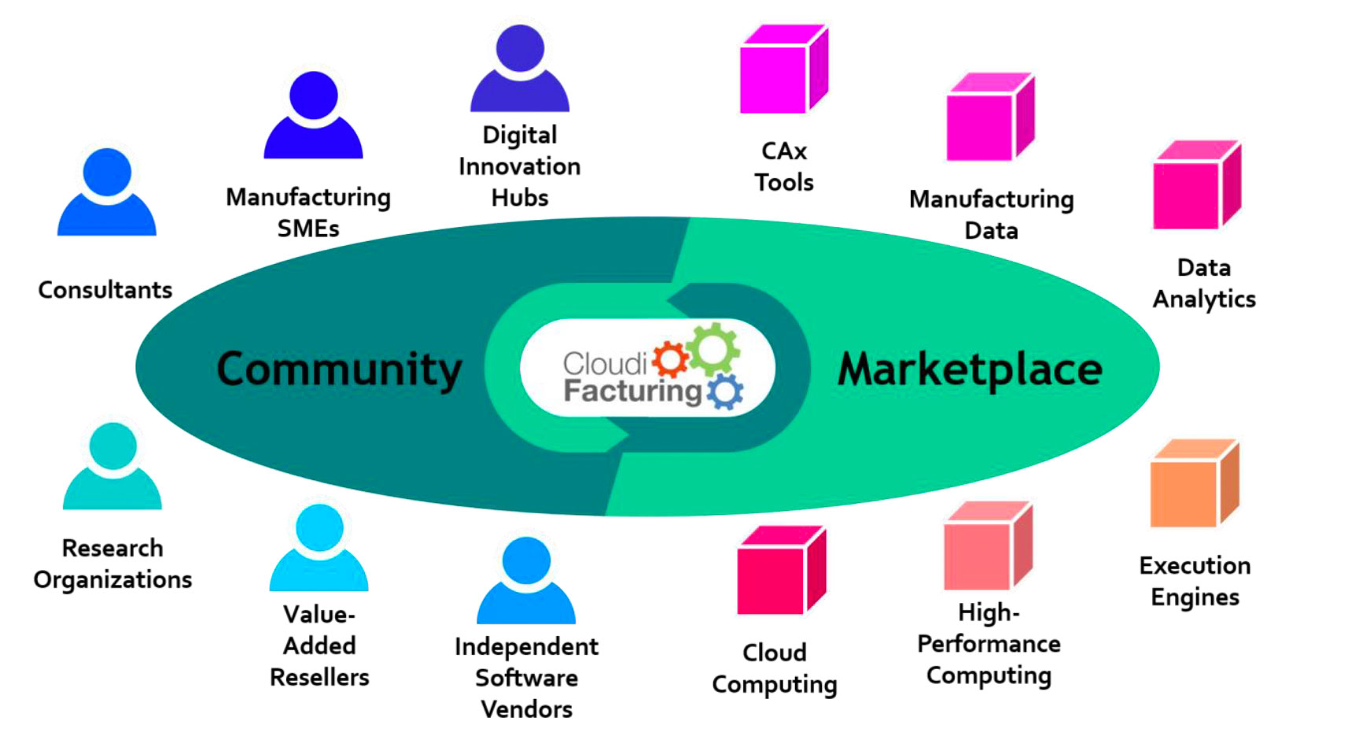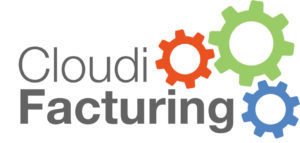The CloudiFacturing Marketplace for Digital Engineering
The CloudiFacturing solution is designed to support manufacturing SMEs and their needs for advanced cloud- or HPC-based ICT solutions. Striving for maximal interoperability, this solution integrates manifold software and hardware platforms, which have emerged from previous projects and research initiatives. Through CloudiFacturing, manufacturing SMEs will be able to seamlessly access all these platforms as if it were just a single one.
All the services offered in the CloudiFacturing Solution will be based on a pay-per-use or subscription business model with a unified billing process, in order to streamline and improve the accessibility to the orchestrated technology without jeopardizing the liquidity of the manufacturing SMEs (see Image below).

The CloudiFacturing Solution will be open, empowering different stakeholders to become members of the community to offer their ICT solutions or consultancy services through an additional distribution channel, or to access advanced cloud-based services (e.g. simulation, analytics, optimisation, etc.) and expert knowledge to boost the company’s competitiveness. The openness of the CloudiFacturing Solution will allow any end user in the context of the product development or production processes, any technology provider (ISVs, VARs, computing resources providers), and any consultancy company to join the CloudiFacturing Solution and to exploit the large network of purpose-affined members; thus, building and generating sophisticated added value.
How does it work?
The CloudiFacturing Marketplace solution needs to support multiple services, in order to enable consumers and providers to get together and benefit from building business relationships with one another.
The domain support very concrete types of operations, assisting visitors in finding the proper services in a consistent manner.
The relationship between domains and types of operations will be defined as follows:
- Guiding and supporting
- Interacting and sharing
- Promoting and showcasing
- Editing and executing
CloudiFacturing Platform Services
Central User Management component
The Central User Management components aims to provide a common user authentication and single-sign-on solution across the platform, securing the data and computational resources. It provides a common database for all user types, including ISVs/VARs and end-users. It also handles different access groups, which is a prerequisite for information sharing across the platforms between different users.
The Central User Management component function relieves the end-user of the burden of handling multiple credentials and relieves other CloudiFacturing components from user and credentials management. The Central User Management component will also provide protection of credentials for accessing external cloud resources.
Central Billing System
The Central Billing System collects usage information from the execution engines and allows to configure different business models for the final users. It keeps track of charges based on configured business models and collected usage information. Further, it provides billing and usage-related reports to be charged to final users based on the business models defined. All usage and billing reports are exposed through an API, which will be accessed by the CloudiFacturing Solution and other CloudiFacturing platform components, respectively. It keeps track of all the orders processed for each registered organization and all the generated bills for each organization.
Repository for Executable Artefacts
The Repository for Executable Artefacts centralises the management of all the artefacts (i.e. workflows or applications) deployed and used by the CloudiFacturing platform. It stores artefact configuration files as an asset of the artefact along with metadata in a defined directory structure. The metadata describes the artefacts and includes information such as versioning, dependencies, and parameters required for running the artefact utilising the specific execution engine.
Workflow and Application Mediator
The task of the Workflow and Application Mediator inside CloudiFacturing is multiple; it is responsible for running workflow and application artefacts from the CloudiFacturing repository, and it is acting as a meta-workflow composition tool for creating and running multi-node workflows of the artefacts registered in the CloudiFacturing repository. It provides a user interface for developing new meta-workflows and managing existing ones. It also has a backend component (API layer) for arranging the different tasks requested by the user. This architecture offers a flexible solution to be easily extended with additional execution engines in the future.
Data Transfer and Browsing System
The Data Transfer and Browsing System provides a service to connect to data storage resources of various types (such as Amazon S3, Generic Storage Service (GSS) for HPC storages, SFTP, OpenStack Swift, etc.) to perform common data management operations using either its graphical user interface or its REST API. It ensures uniform management of all these diverse storage types and allows for transferring data between any of these resources in a secure and fault-tolerant way. It also provides an option for the end-users to upload input data for the workflows to be executed and to download the results. It can furthermore be used to exchange data automatically in piped applications to pass output of the previous application to the subsequent application as input.
Supported Execution Engines
SemWES Platform
The SemWES platform provides a workflow execution tool, where a workflow is defined as a set of calculations, simulations, or analytics tasks, which are executed for some specific user input. The scope of application of the SemWES platform are complex engineering and manufacturing workflows from simulation-based design all the way to analytics of production data and result visualization.
CloudBroker Platform
The CloudBroker platform is a backend tool for the deployment, management and running of compute intensive software on various cloud infrastructures. The CloudBroker platform uses IaaS from resource providers and provides PaaS to software vendors, and SaaS to end users. It allows users to register, deploy, charge for and use their own cloud resources and application software or use resources and software provided by others.
Flowbster Engine
The Flowbster engine is a cloud-oriented workflow system on the top of the Occopus orchestrator (available within the CloudBroker platform). It was designed to create efficient data pipelines by which very large data sets can efficiently be processed in clouds. A Flowbster workflow can be deployed in the target cloud as a virtual infrastructure through which the data to be processed can flow and while it flows through the workflow, it is transformed according to the workflow's business logic.

 The project CloudiFacturing receives funding from the European Union’s Horizon2020 research and innovation programme (Grant No. 768892).
The project CloudiFacturing receives funding from the European Union’s Horizon2020 research and innovation programme (Grant No. 768892).
